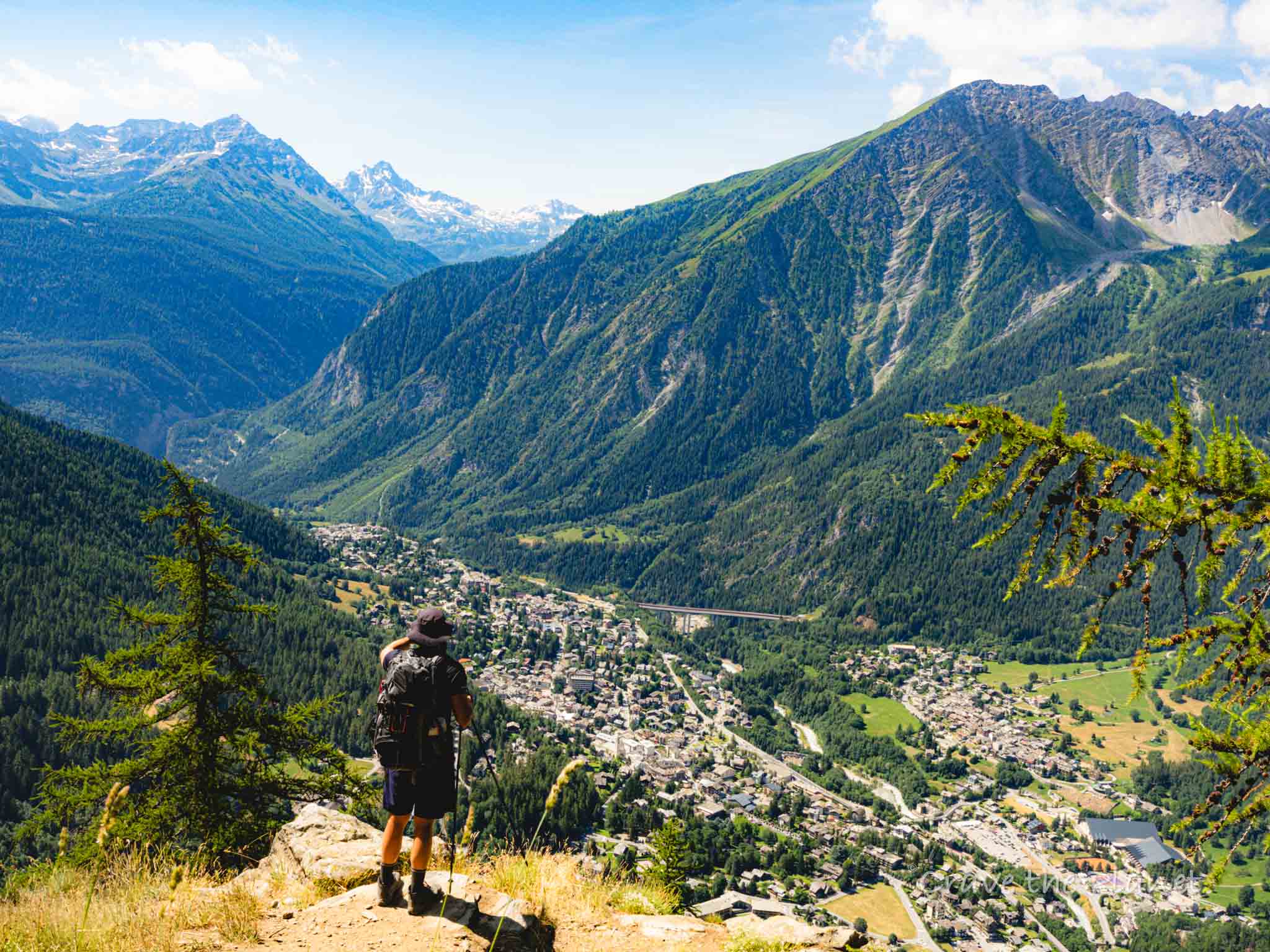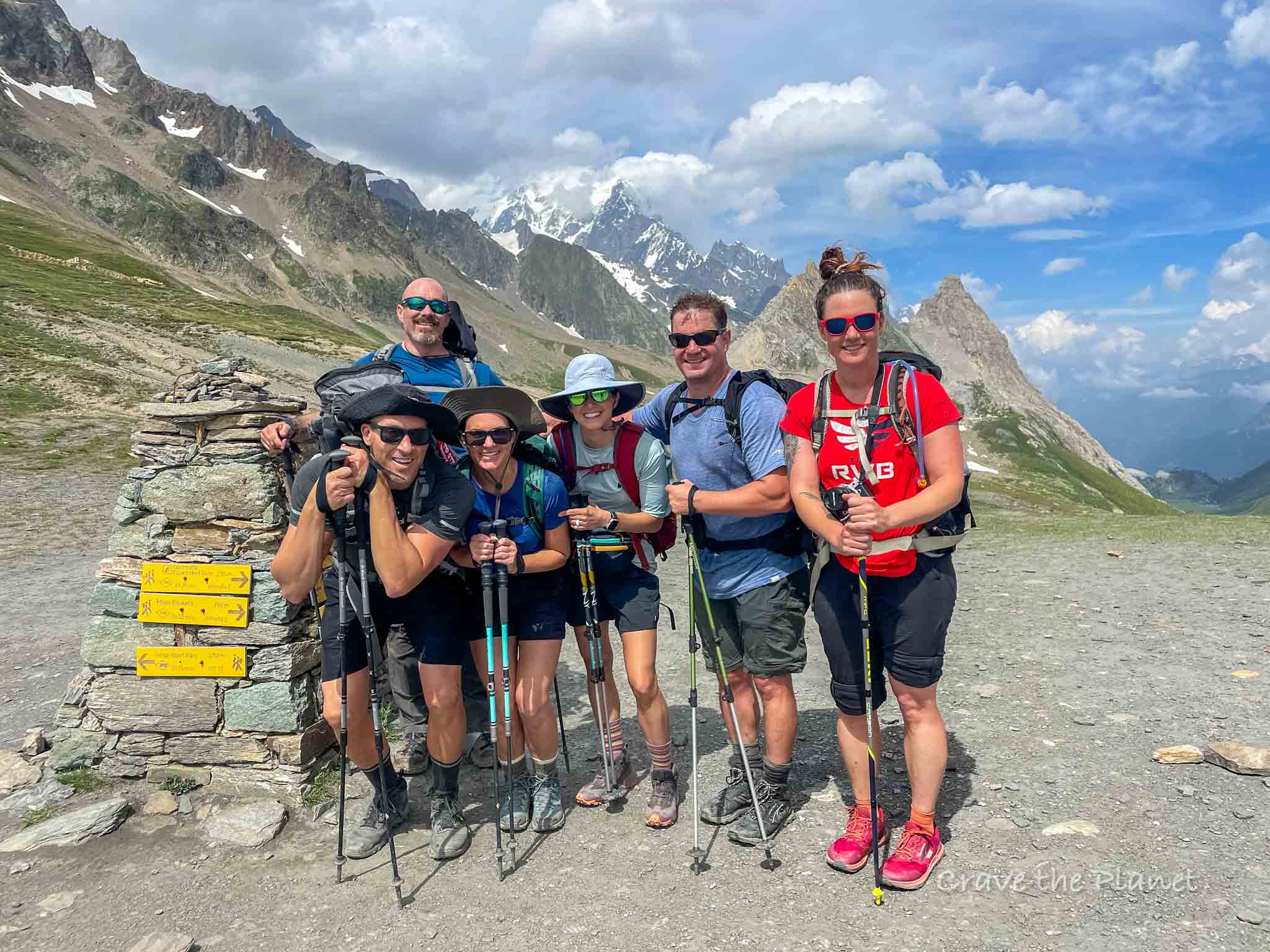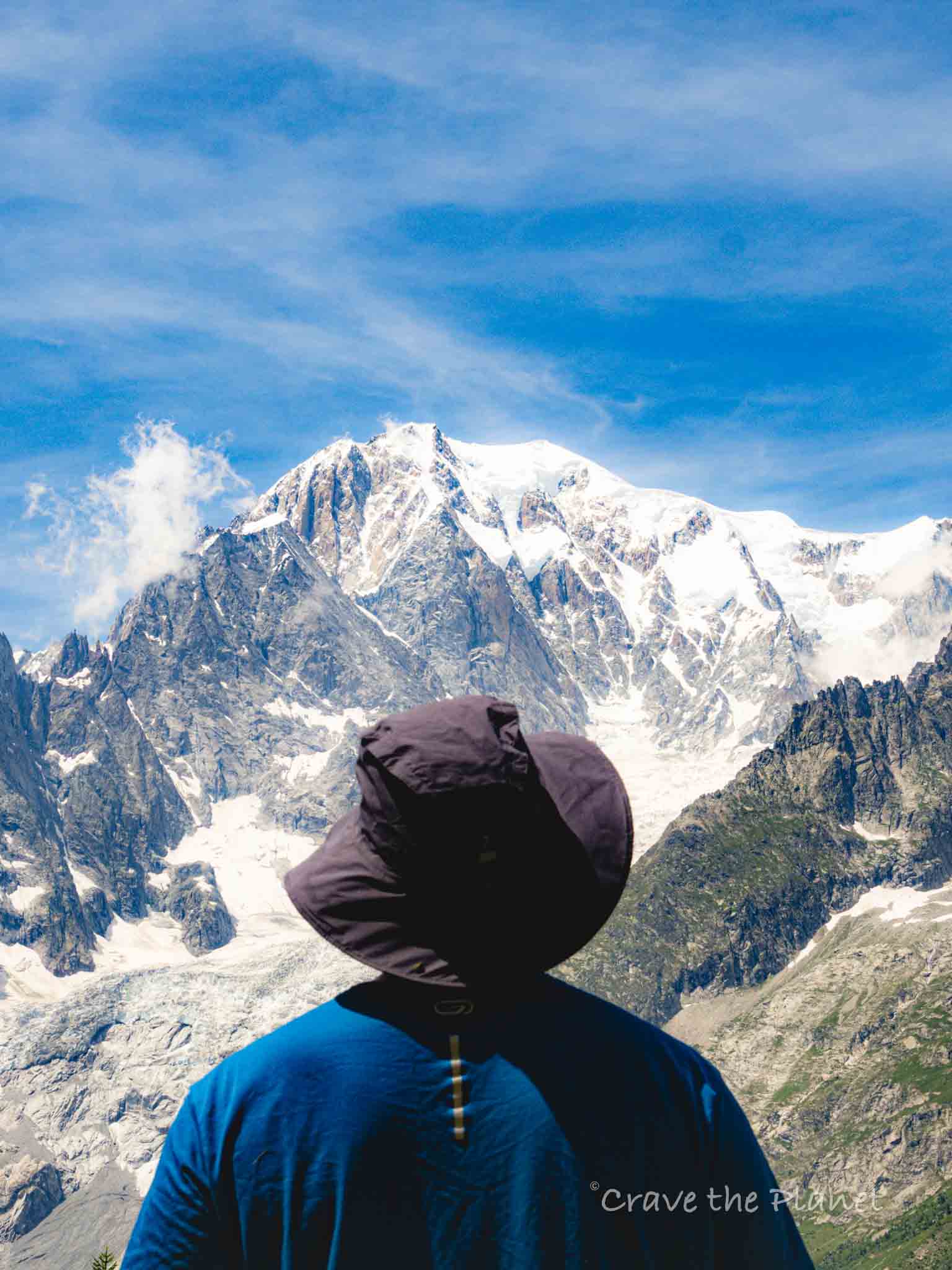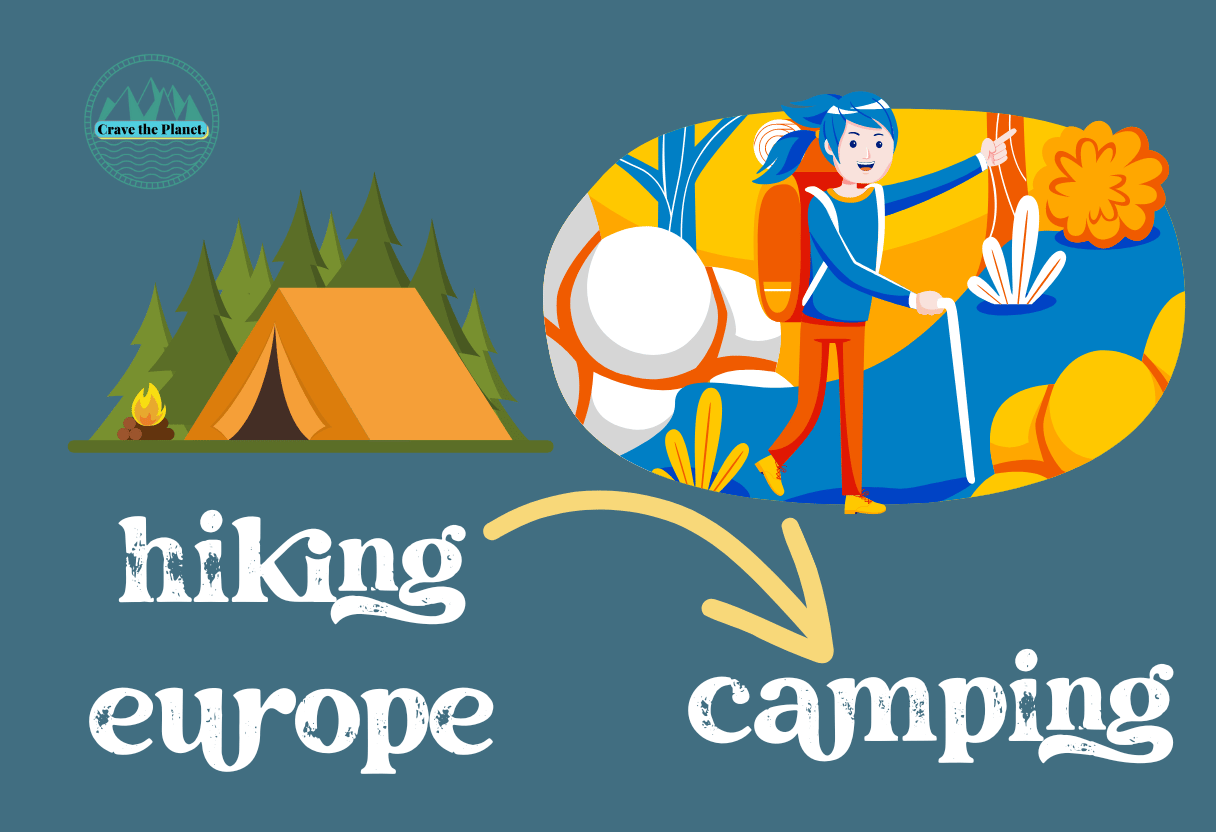If you’re looking for an honest guide on the Tour Du Mont Blanc cost, you’ve come to the right place!
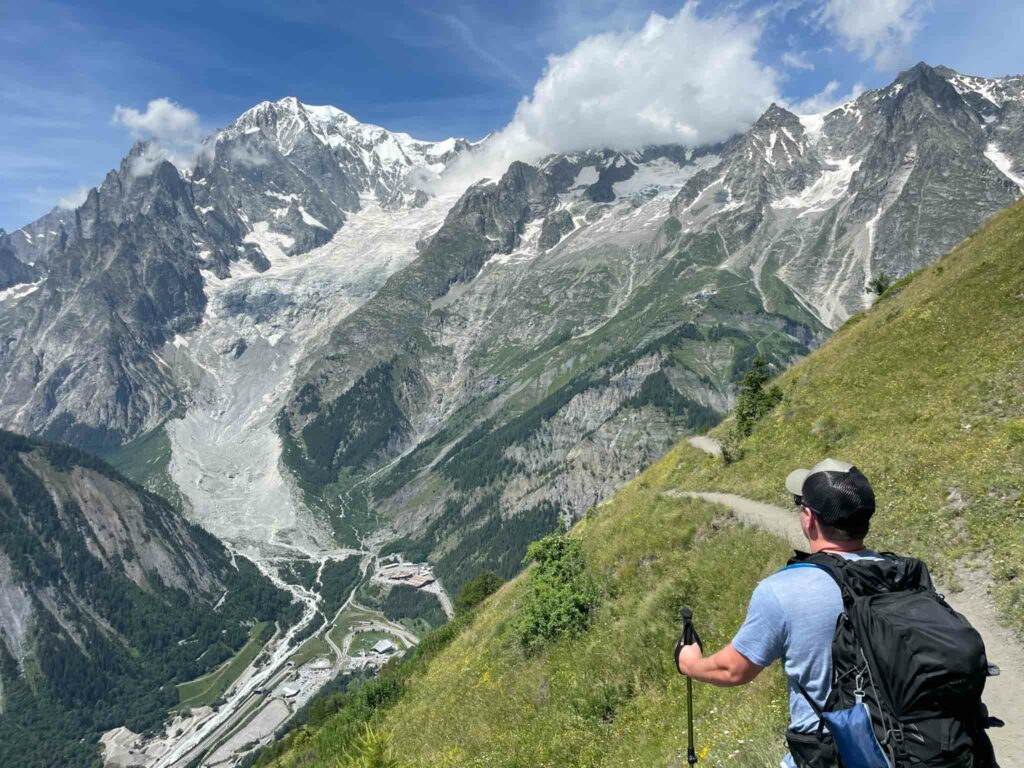
And yes, hiking the TMB is definitely worth it! This is a dream trek (hike) that should be on your bucket list, but there’s only a short window of time to hike the TMB.
The cost will depend on a variety of factors but mainly whether you want to go self-guided, guided, camping or DIY. It can get complicated quickly and there are some very good TMB planners that can help you every step of the way.
Read until the end where I share the very best deals for each way of hiking the TMB.
What is the Tour Du Mont Blanc Cost?
Authors TL;DR: ➡️ For a 10-day TMB hike, which can be completed faster or slower depending on your schedule, a couple from the US can expect to spend anywhere from $2500 to $8500, with the biggest expenses being flights and accommodations.
However, there are plenty of ways to make this experience more cost-effective without sacrificing too much comfort.
In this post, we’ll provide suggestions on how to lower your expenses while still enjoying the majestic views and diverse terrain of TMB.
Tour du Mont Blanc Cost Summary
Your Mileage May Vary, This is my Estimate
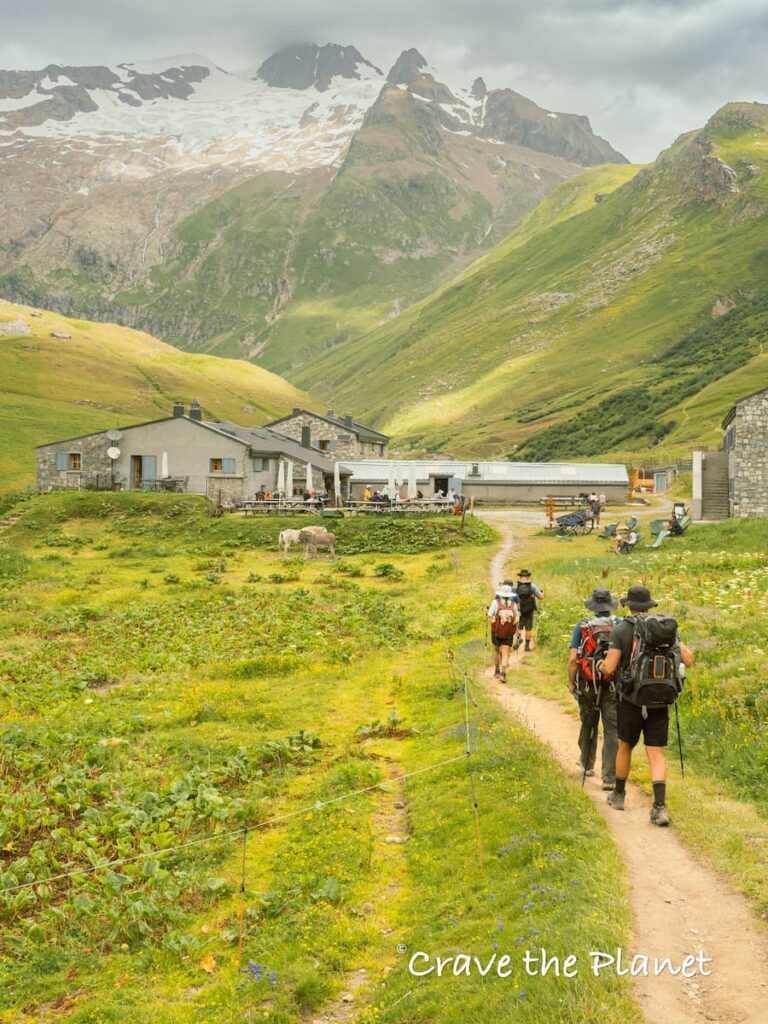
- Flights: Go to Geneva $1,000-$1,500
- Airport Transfer: $20-100
- Luggage Transfer: $75-300
- Gondolas: $0-100
- Accommodations: $10 (camping) – 250 (nice hotel)/night
- Food Varies: Supermarkets to fine dining. Half board included in huts.
- Wine: Reasonable $15-30/bottle
- Trekking Insurance: depends
I have made an effort to keep track of our expenses during our summer hike 5 day hike on the TMB in 2023. We splurged on paragliding in Chamonix and you probably should to!
Although it is not the most expensive hiking destination, it is certainly not cheap, especially with the 10 euro beers at Refuge de La Balme!
Tour du Mont Blanc Costs Guided vs Self-Guided Best Deals
Morgan’s TMB Video : See What it’s Like
9 Main Costs of Tour du Mont Blanc
1. Air Travel from the USA
When planning your TMB hike, it is important to consider the most convenient location to fly into. Geneva, Switzerland is a popular starting point for TMB, and a shuttle transfer can take you to Chamonix, France where the hike begins. Les Houches is the official starting point of the hike.
Flight prices can vary greatly depending on the time of the year and where you are flying from. To get the best deal, consider flying during a weekday, not on holiday, and during shoulder months. From Atlanta to Geneva, leaving the first week of September and returning the last week of September, we paid $1250/person.
Here are some important points to keep in mind when booking your air travel from the USA:
- Geneva, Switzerland is a popular starting point for TMB
- Consider taking a shuttle transfer to Chamonix, France where the hike begins
- Les Houches is the official starting point of the hike
- Flight prices can vary greatly depending on the time of the year and where you are flying from
- To get the best deal, consider flying during a weekday, not on holiday, and during shoulder months
Remember to do your research and book your flights in advance to get the best deal.
2. Airport Transfer
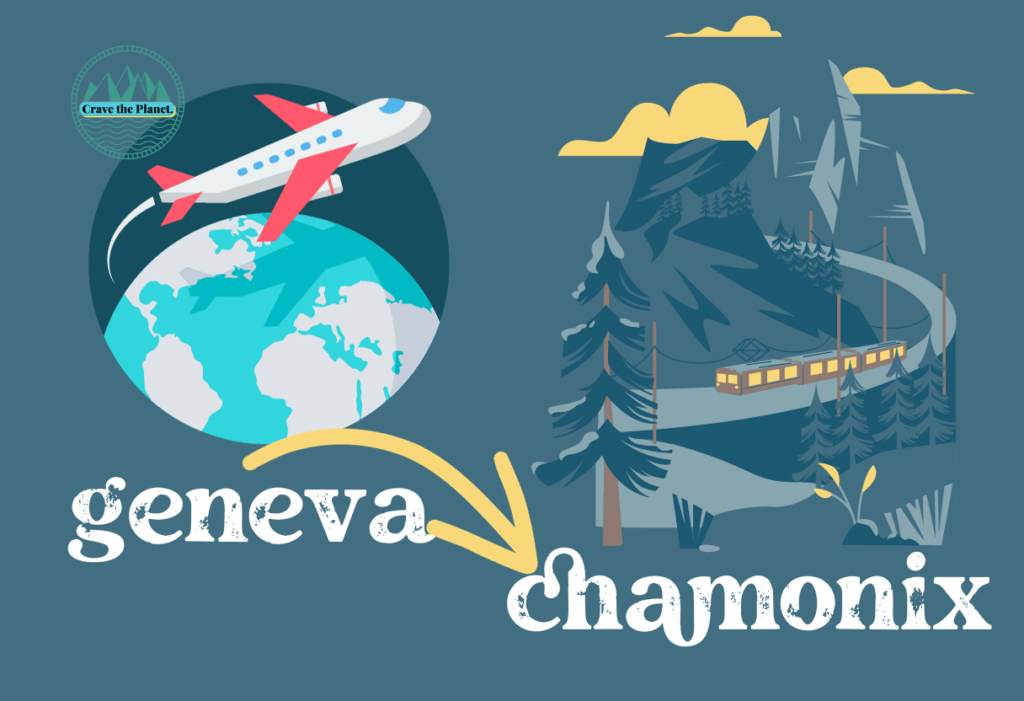
When traveling from Geneva to Chamonix, there are several transportation options available to you. Your choice of transportation will depend on your budget. Here are the most common ways to transfer from Geneva to Chamonix:
- Shuttle Bus: The shuttle transfer is the most popular way to travel to Chamonix. It is convenient, reasonably priced, and takes approximately 75 minutes. You can book online or in-person. During peak season, it is recommended to book ahead of time. Private shuttles are available for larger parties. Chamonix Valley Transfers is a popular shuttle company that charges $53 per person.
- Bus: Buses are another convenient option to get from Geneva Airport to Chamonix. There is a bus station at the airport, and the journey takes between 1.5 to 2 hours. The cost depends on the number of stops, but it usually ranges from $12 to $30. BlaBla Car Bus, EasyBus, and FlixBus are some of the popular bus companies.
- Train: Although it is the least convenient option, a train journey from Geneva to Chamonix takes approximately 3 to 4 hours and requires multiple train changes. The cost ranges from $25 to $56 per person.
- Car Rental and Taxi: Car rentals and taxis are more expensive options. Renting a car is not necessary unless you plan to explore other parts of the country before starting the hike. Renting a car or hiring a taxi can cost at least a couple of hundred dollars.
The shuttle transfer is the most popular and convenient way to travel from Geneva to Chamonix. Buses are another affordable option, while trains are the least convenient and most time-consuming.
Car rentals and taxis are expensive and not necessary unless you plan to explore other parts of the country.
3. Luggage Transfer
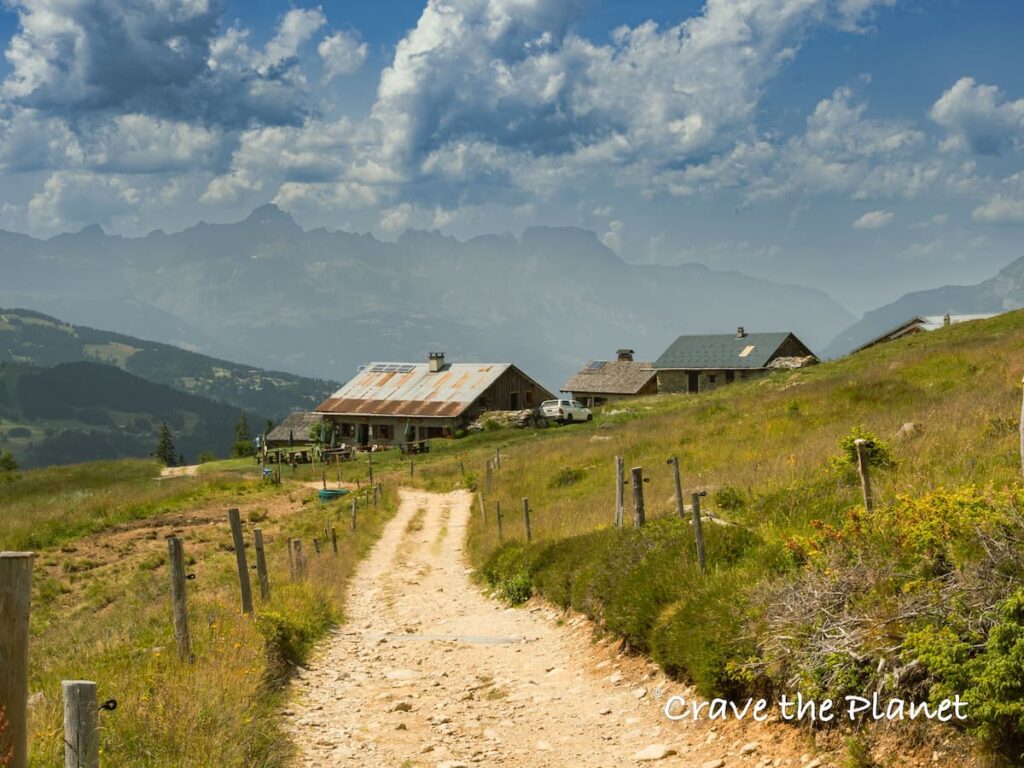
To make your hike more comfortable, you can use a luggage transfer service to transport your bags from one accommodation to another. However, keep in mind that this service is only available for mountain huts (refuges), hotels, and staffed camping grounds.
We have always chosen to carry our things and leave “normal” clothing in a parked car or with a previous hotel. Everyone smells on the TMB anyways. But you do you if you need luggage transportation it’s available.
BnB accommodations, private accommodations, accommodations without reception service, and some mountain huts like Rifugio Bonatti are not included in this service.
You can easily find this information on the website of each transfer service company.
There are three main companies that offer luggage transfer services.
Chamonix Valley Transfers offers a flat rate of $705 (€600) for up to 14 bags, which is a great deal for large groups. The weight limit for each bag is 15 kg (33 lb.).
Besson Transports Taxi Mont Blanc provides a customized quote depending on the number of bags you have and all the places you would like the luggage transferred to. They have a very user-friendly website that allows you to enter all the necessary information and provides you with an immediate quote.
For a friend’s hike, they had one luggage piece delivered to every accommodation except Rifugio Bonatti, and the cost was $297 (€250) per bag. The weight limit for each bag is also 15 kg (33 lb.).
Tip: If you want to save money, you can carry everything yourself or split the cost with someone else.
Keep in mind that if you have extra luggage that you are not taking on the trail, your hotel may have a storage room where you can leave it. Some luggage transfer companies also offer free storage for your extra luggage. This can reduce your Tour. du Mont Blanc cost significantly.
Here are some important tips to keep in mind when using a luggage transfer service:
- Make sure that the name on your accommodations reservation matches the name on your luggage transfer service reservation. This is the only way for them to verify that they are delivering to the correct place.
- The weight limit for each bag is 15 kg (33 lb.).
- BnB accommodations, private accommodations, accommodations without reception service, and some mountain huts like Rifugio Bonatti are not included in the luggage transfer service.
Using a luggage transfer service can make your hike more comfortable, but make sure to plan ahead and choose the service that best fits your needs.
4. Gondolas and Chairlifts
During the Tour du Mont Blanc, you may utilize cable cars, trains, and buses to move around the valley. Chamonix Valley Bus and Train Transfers are reliable and affordable ways to move around the valley.
If you are staying in one of the hotels in the valley, you will receive a free ticket to ride the bus or train during your stay with the Carte d’Hôte (Guest Card). Otherwise, it is €1.5 per ticket.
Cable cars are a great way to avoid some of the ascends or descends to preserve your knees, but they can be pricy starting at $17 one way. Most of them close at the end of the season in August and may not be available if you are hiking in September.
Important points:
- Use Chamonix Valley Bus and Train Transfers to move around the valley.
- You will receive a free ticket with the Carte d’Hôte (Guest Card) if you are staying in one of the hotels in the valley.
- Cable cars are a great way to avoid some of the ascends or descends to preserve your knees.
- Cable cars can be pricy starting at $17 one way.
- Most cable cars close at the end of the season in August and may not be available if you are hiking in September.
5. Accommodations
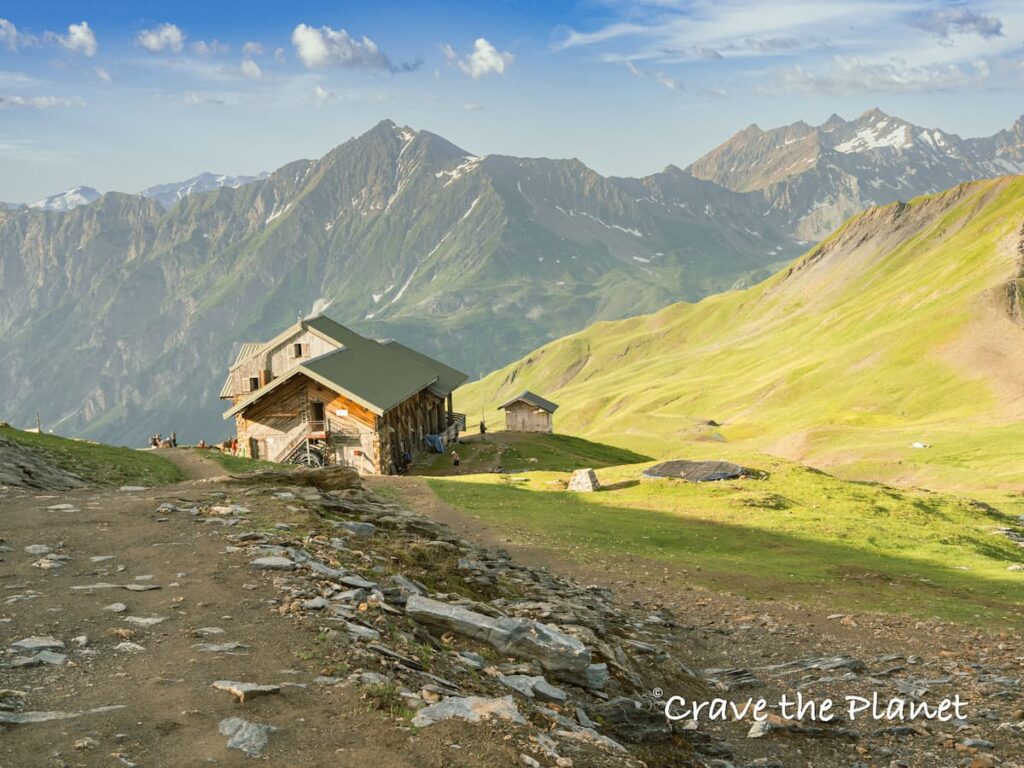
When it comes to accommodations, there are several options available to you on the Tour du Mont Blanc.
- The cheapest option is camping, with campsites costing anywhere between $10-$30 per night. However, wild camping is not allowed and campsites must be reserved in advance.
- Mountain huts, or refuges, are a more expensive option but still popular among hikers. With half-board, which includes overnight stay, dinner, and breakfast, they cost anywhere between $50-$95 per night. Showers, towels, and packed lunches may come at an additional cost.
- Hotels are the most expensive option, with prices ranging from $75-$350 per night. However, some hotels are fairly reasonable in price. Most hotels include breakfast in the price.
- Private rooms with showers in refuges are also available, but they are more expensive than dorm-style accommodations.
Most hikers use a combination of camping, refuges, and hotels for their accommodations.
For 10 days of hiking, the cost for both camping and hotel accommodations can be approximately $2000.
It is important to note that private rooms with showers in refuges and hotels with better views and balconies will cost more.
For more detailed information on accommodations ➡️ TMB List of Accommodations
6. Food and Snacks
One of the benefits of the Tour du Mont Blanc hike is that you don’t need to carry much food with you as you will be passing through villages and towns every day where you can restock.
You can either stop at a refuge on the trail for lunch or have your accommodations pack a lunch for you. The cost for a refuge/hotel to prepare lunch for you is between $9-$12 per person, and about the same if you stop somewhere for lunch.
If dinner is not included in your accommodations, it usually costs $25-$50 per person.
The cost of food and snacks can vary significantly depending on your taste, the restaurants you visit, and if you like to cap the night off with a nice bottle of wine.
Some food options you may encounter on your hike include:
- Breakfast: Depending on your accommodations, breakfast may be included in the price or available for an additional fee. You may be able to find breakfast options at local cafes and bakeries as well.
- Packed Lunch: Many accommodations can prepare a packed lunch for you to take on the trail.
- Dinner: If dinner is not included in your accommodations, you can find a variety of restaurants and cafes along the way.
- Snacks: You can find a variety of snacks at local grocery stores and supermarkets along the route. Cheeses, bread, and dried meats are popular options.
- Drinks: You can find a variety of drinks at local cafes and restaurants along the route. Wine, beer, coffee, and tea are popular options.
The cost of food and snacks can add up quickly, so it’s important to budget accordingly. The Tour du Mont Blanc Cost Breakdown Table shows that food and snacks can cost around $300 for a 10-day hike for two people on a budget travel option, and up to $1000 for luxury travel options.
Remember to pack some snacks and water for the trail, but don’t worry too much about food as you will have plenty of options along the way.
7. Gear
Okay okay, this one is actually pretty good. Unless you’re going to camp, you won’t need a whole lot for hiking on the TMB as the huts provide most of what you need.
Certainly the most important thing to have are sturdy legs so you’ll need a gym membership – just kidding!
While the trek is strenuous with a lot of elevation gain each day, it’s more of a hike than a “trek”.
If you are starting from absolute scratch, I wouldn’t recommend the TMB.
So most of you will have what you need: good footwear, rain gear, trekking poles, hiking clothes, a comfortable backpack and sun protection.
The only special thing you’ll need for the huts are a sleep sac, earplugs and cash to buy wine. And btw: it’s hit or miss if you can bring trekking poles on a plane.
Check out my list of the minimalist gear needed.
8. Trekking Insurance
In case of emergency 👉 Rescue Insurance
Crave the Planet partners with Global Rescue to offer the world’s leading travel protection services. Medical and security emergencies happen. When they do, we rely on Global Rescue to provide our clients with medical, security, travel risk and crisis response services.
Without a membership, an emergency evacuation could cost over $100,000. More than one million members trust Global Rescue to get them home safely when the unexpected happens. Learn more about trekking insurance, but we highly recommend our audience enroll with Global Rescue.
Pros and Cons
- Comprehensive Emergency Services: Members have access to a wide array of emergency services, including medical and security evacuations, field rescues, and telemedicine consultations.
- Global Coverage: Global Rescue operates around the world, offering support and evacuation services in both remote and urban settings, which is particularly beneficial for travelers and adventurers.
- Expertise and Resources: The company is well-regarded for its team of medical and security experts and has a partnership with Johns Hopkins Medicine, ensuring high-quality advice and care.
- Cost Factor: The membership can be expensive, especially for those who travel infrequently or are on a limited budget.
- Membership vs. Per-Trip Insurance: Since the services are membership-based, they may not be as cost-effective for those seeking coverage for a single trip as opposed to regular travelers.
- Limited Traditional Travel Insurance Benefits: The membership focuses on emergency evacuation and rescue, which means it may lack comprehensive trip insurance features like trip cancellation, baggage loss, or delay coverage.
9. Guided or Self-Guided Tour?
When deciding whether to choose a guided or self-guided tour for Tour du Mont Blanc, there are a few factors to consider.
While the trail is well-marked and guides are not necessary, some people may feel more comfortable with a guide or hiring a tour company to manage all accommodations and provide all the materials for a self-guided tour.
Guided tours come with the added benefit of a guide, who can provide insight into the history and culture of the area.
🥾 Ready to book your 2024 TMB hut to hut hike??
Hike your own hike. If you want to spend less time, then my personal recommendation is to choose Alpenventures Unguided Self-Guided Hut to Hut Hiking Tours, with a self-guided tour, you’ll have all the information and resources you need at your fingertips, so you can spend less time planning and more time enjoying the stunning beauty of the Alps.
Find Your TMB Hiking Adventure HEREAdditionally, all accommodations, dinners, and breakfasts are covered, but lunches, snacks, airport transfers, and luggage transfers may come at an additional cost.
Some guided tours can be as expensive as $6255 per person, which may not be feasible for everyone.
Self-guided tours, on the other hand, offer more flexibility and can be more cost-effective. Self-guided tours start at approximately $1800 per person, but this price may not include dinners for all accommodations, lunches, private rooms, luggage, or airport transfers.
However, by booking your own accommodations and arranging transfers, you can save quite a bit of money.
If you decide to go with a self-guided tour, it is important to note that the ability to complete the hike in less than ten days can save costs, as well as opting for lower-cost accommodations.
Switzerland is the most expensive country of the three, so arranging to spend the least amount of time there can help with the budget too.
Here are some important points to consider when deciding between a guided or self-guided tour:
- Guided tours offer the benefit of a guide, but can be more expensive.
- Self-guided tours offer more flexibility and can be more cost-effective, but may require more planning and research.
- When booking a self-guided tour, make sure to factor in additional costs such as meals, transfers, and accommodations.
- Completing the hike in less than ten days and opting for lower-cost accommodations can help save costs.
- Switzerland is the most expensive country of the three, so spending less time there can help with the budget.
Ultimately, the decision between a guided or self-guided tour depends on your personal preferences and budget.
With proper planning and research, a self-guided tour can be a great option for those looking to save costs and enjoy the flexibility of the trail.
Final Verdict: Ways to Book a Hut to Hut Hiking Trip
Self-Guided Tour Planning Service
- [Self-Guided] - You're on your own once you start
- Must book in Oct to Jan of year prior to hike
- Fully done for you route
- Service finds and books your huts
- Maps provided on app
- small groups (<10 typically)
- local Chamonix guides
- all transfers/breakfast/dinner/accommodations included
- airport transfer included
- stay in the insanely beautiful Rifugio Bonatti and other huts at high elevation
- Cheapest Option
- Most Freedom
- Take side excursions as you like
Camping
- campgrounds can be crowded
- reservations often needed in advance
- Wild camping is prohibited or limited by elevation
Frequently Asked Questions
Average Cost of a Guided Tour du Mont Blanc
If you’re planning to take a guided Tour du Mont Blanc, the average cost can vary depending on the length of the tour and the services included. On average, a 10-day guided tour can cost around €2000-€3000 per person. However, this cost can increase if you opt for additional services such as luggage transfer, accommodations, and meals.
Differences in Cost between a Guided and Self-Guided Tour du Mont Blanc
Self-guided tours are generally less expensive than guided tours, but you’ll have to plan your itinerary and arrange accommodations and meals yourself. The cost of a self-guided tour can vary depending on the services you choose, but on average, a 10-day self-guided tour can cost around €1000-€2000 per person. Keep in mind that the cost can vary depending on whether you choose to camp or stay in accommodations along the route.
Typical Itinerary for a 5-day Tour du Mont Blanc
A 5-day Tour du Mont Blanc itinerary is a shorter version of the classic 10-day route. The itinerary can vary depending on your starting point, but generally, it includes hiking through France, Italy, and Switzerland. A typical 5-day itinerary includes hiking for 4-6 hours per day and staying in accommodations along the route.
Best Mont Blanc Hiking Tours and Their Costs
There are many Mont Blanc hiking tours available, each with its own unique itinerary and cost. While I wouldn’t recommend hikers actually climb Mont Blanc, hiking around it is pretty amazing. Some popular options include the Mont Blanc Highlights Tour, the Mont Blanc Family Tour, and the Mont Blanc Circuit. The cost of these tours can vary depending on the length of the tour and the services included, but on average, they can range from €1000-€3000 per person.
⭐️⭐️⭐️Best Guided Tour for Beginners - 4 Days Tour du Mont Blanc Hike
Based on my personal experience, Skyhook Adventures offers the best 4 day TMB hiking experience that's do-able for most people.
Perfect option for busy people that just want to show up, feel safe with a guide and hike without doing any logistics.
The tour features small groups (<10 typically) and
- all transfers/breakfast/dinner/accommodations included
- airport transfer included
- stay in the insanely beautiful Rifugio Bonatti and other huts at high elevation
Note: Skyhook hires only local Chamonix guides.
Difficulty Level of the Tour du Mont Blanc and How It Affects Cost
The Tour du Mont Blanc is a challenging hike, with steep ascents and descents, high altitude, and unpredictable weather conditions. The difficulty level of the hike can affect the cost, as guided tours with experienced guides and additional services such as luggage transfer and accommodations can be more expensive. However, opting for a self-guided tour can be less expensive, but you’ll need to be prepared for the physical demands of the hike.
Resources for Booking a Tour du Mont Blanc and Comparing Costs
There are many resources available for booking a Tour du Mont Blanc, including tour operators, travel agencies, and online booking platforms. It’s important to compare costs and services offered by different providers to find the best option for your budget and preferences. Some popular resources for booking a Tour du Mont Blanc include Alpenventures Unguided for self-guided, Skyhook Adventures for a guided hike, and my TMB post for DIY.
Planning your trip?
- 🏨 Book your perfect stay on Booking.com
- 🎢 Make your trip more exciting with GetYourGuide
- 🚗 Hire a car with Discover Cars
- ✈️ Find cheap flight tickets with WayAway
- 📲 Buy eSIMs with Airalo
- 🥾 Get off the beaten tourist path with Fully Planned and Booked Self-Guided Hut to Hut Hiking Trip
- 🥾⭐️ Step into social adventure with Guided Group Hut to Hut Hiking Tours in Europe.
We hope this guide to the Tour du Mont Blanc costs has given you the proper information to plan your adventure.

Author profile: Morgan Fielder is a Doctor of Physical Therapy and passionate hiker who believes in exploring the world on foot with good food. Follow her journey as she shares science-based hiking tips and advocates for sustainable tourism.

